
(Below) Prof. Ravi Kumar showing Anila stove.
By Depalan
Mysore :
Prof. U.N. Ravi Kumar is a man driven by passion and reminds you of what Aristotle once wrote ‘Energy of mind is essence of life’. A practical man that he is, Prof. Kumar has taken a step further, from creating awareness to creating actionable awareness. He is a pioneer of sorts as when he was a Professor at National Institute of Engineering (NIE), Mysore, he initiated the Centre for Appropriate Rural Technology (CART).
There was a realisation that there were many technologies available for rural development but the target group for whom these technologies are designed, namely the rural and the poor, were not getting the benefits due to lack of proper implementation. Prof. Kumar firmly held Gandhian thought of technology as a means to empower and not to enslave.
Accordingly the Centre, under his aegis, took initiative to collect available information on rural technologies, compile them and methods to disseminate them to people needing technological assistance. He is known for his tireless efforts in Ecological Sanitation as also Rainwater Harvesting and Biochar Stove. The common feature being dissemination of technology in a practical and sustainable manner, using locally available materials and requirements that makes it affordable and easy to use.
Ecological Sanitation or EcoSan is sustainable and eco-friendly model for toilet which conserves water, prevents contamination and recycles human waste as sanitised manure. The objective being to protect human health and environment while reducing water consumption in sanitation system and recycling nutrients to help reduce need for artificial fertiliser in agriculture.
EcoSan works on the principle of keeping the solid waste separate from liquid, consequently there is a separate exit for urine. Unlike faeces, urine is full of nutrients hence diluted and used as fertilizer. Sanitation is a major issue in India with staggering 65% people not having access to proper sanitation facilities and forced into open defecation. These open faeces are extremely harmful and contaminate air, water and soil.
This has contributed to spread of communicable diseases. Lack of water is a major concern as also the cost involved in laying drainage system and so on. This is where EcoSan toilets gain critical significance. Further, even in areas where water tables are at comfortable levels the flush toilets and septic tank seepages tend to contaminate groundwater and thus are polluting and disease spreading. The case is worsened in water logged areas.
EcoSan provides a perfect solution to these problems and has revolutionary potentials. It is a safe, sustainable and affordable sanitation solution. With increasing population and pressure on natural resources, EcoSan provides an effective alternative model.
There are roadblocks, the most important being, as Prof Ravi Kumar puts it “we have faecal-phobia”, we as a society don’t want to talk about faeces or matters related to toilet. “We just want to flush it down, literally!” This issue also has socio-historical baggage and tends to excite extreme emotions among people. The reason why these are neglected at the policy making level, ironically with detrimental effect on common people. Thankfully with much determination and persuasion EcoSan is now functioning as a pilot project in three locations at Udupi, Bangalore rural and Raichur district through UNICEF intervention.
As a community initiative, EcoSan toilets have been adopted in Mosara Halla in H.D. Kote and Kurabara Kunte in Devanahalli as also by schools in Doddaballapur, Krishnapura, Moodalakoppal and Kempammanahosur.
EcoSan toilet’s spin off benefit too is significant in terms of organic manure. “This will reduce the dependence on chemical fertilisers” asserts Prof. Kumar. Many farmers are falling into debt due deteriorating soil nutrient content caused by intensive use of chemical fertilisers, they are trapped in a vicious attritional cycle. Prof. Kumar informs “an individual’s faeces produces 7.5 kg of NPK over a year, this is the manure requirement for cereals that is consumed by an individual in a year. Life is in a self sustaining cycle”. It is not that these are new knowledge; many communities have been practicing these since ages like for instance the Tibetans.
Prof. Kumar points to Mahatma Gandhi as a source of inspiration, when he visited Wardha he found that Gandhiji practiced compost toilets. EcoSan generates opportunities that add value to human waste and decentralised waste management. Prof. Kumar has also been instrumental in the creation of Nesara, an organic farmer’s community in Mysore with a motto of safe food at affordable price.
Prof. Kumar took me to the porch of his house to show the model of Biochar stove, called Anila, he had developed that has earned him international repute. It is unique in its design as biomass fuel is placed between two concentric cylinders while the outer filling biomass undergoes pyrolysis thus produces biochar, these activated carbon helps in heat recovery and also negligible smoke.
Biochar has appreciable carbon sequestration value and is a soil enhancer, these highly porous charcoal helps retain soil nutrients and water. Also, biomass of any sizes could be added and therefore is not dependent on wood. “In villages there is a substantial bio-residues during agriculture related activities that go waste, like arecanut husk or coconut shell these can be turned into efficient biofuel and biochar manure,” informs Prof. Kumar.
Anila is a cost effective and efficient smokeless stove that is ‘carbon negative’. Though there is a demand for the stove in rural areas, Prof. Kumar is gloomy as he is not able to break even. There is an institutional support needed for these efforts apart from of course policy making that understands the needs of common people and sustainable development.
e-mail: depalan@gmail.com
[Depalan conducts Nature Walks in and around Mysore. He can be visited at www.iseeebirds.blogspot.com]
source: http://www.starofmysore.com / Star of Mysore / Home> Feature Articles / November 28th, 2013








